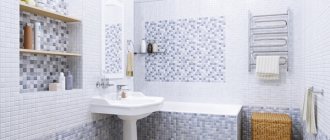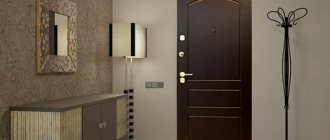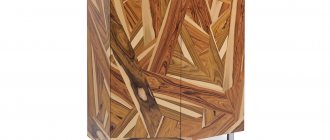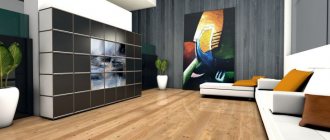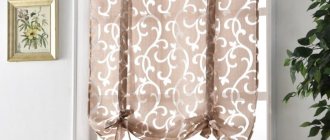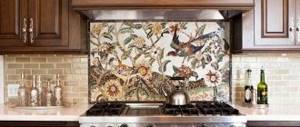Mirror floor tiles are considered a novelty in indoor cladding. Laying this kind of material in the form of a mirror is not difficult, since it is done in the same way as covering walls and floors with simple ceramics. It’s just that the adhesives, grouts, tiles (glass or mirror) and the tools used are different. Therefore, many people are concerned about the question of how to glue mirror tiles and what adhesive composition to choose for it.
Grouting and laying mirror tiles
In our article we will look at how to glue mirror products, the main subtleties of the work, and what needs to be done to ensure that cladding with glass or mirror materials of different textures and colors is done in the best possible way.
Preparation
Before gluing the glass product, it is recommended to carefully prepare the base. In this case, it is necessary to clean the wall from dust, dirt, oil stains and paint. If there are irregularities, holes, chips and other defects, they should also be repaired with cement-sand mortar. If there are large differences in height, the surface is completely plastered.
Preparatory work before gluing glass products
Grout: features
A characteristic feature of mosaics is a large number of gaps, so they will have to be filled with a special compound. If this is not done, the coating will quickly become unusable. As you know, it is necessary to rub mosaics for the following reasons:
- To protect the wall and floor covering in a room with a high level of humidity (for example, in a shower room) from the negative effects of moisture. If you do not fill the seams of the mosaic, mold or mildew will form in them over time. In addition, dirt will constantly accumulate in the joints.
- To disguise unevenness, seams, residual adhesive solution, chips and other defects.
- For surface decoration.
The durability of the mosaic-lined coating depends on the quality of the grouting work.
Laying mirror mosaics without color
The surface of the walls is covered with glass tiles a couple of minutes after applying the adhesive composition to the transparent fragment. Then the tile is gently pressed for a few seconds. Laying is recommended to be done from bottom to top. In this case, be sure to use a building level to check the correctness of the laying of the material.
Important! To ensure the same gap between the individual fragments of the facing material, it is worth additionally using crosses.
REMOVAL OF GROUT FROM THE SURFACE OF TILES AND MOSAICS
It should be noted that the question of how to clean grout from tiles concerns almost everyone who has recently completed renovations in the bathroom or kitchen. Many people are also interested in how to clean the grout itself and how it can be protected from contamination.
Many manufacturers of finishing materials recommend the use of special compounds that provide a water-repellent effect. For example, the Atlas Delfin composition is quite popular. True, you need to keep in mind that the use of such compositions is justified only if you used the most ordinary grout to fill the mosaic joints.
READ MORE: Features of choosing a washing machine with a clothes drying function
But if epoxy grout was used, no additional processing is required. Epoxy grout is good because it is practically not susceptible to contamination. And if dirt gets on it, it won’t be difficult to wash it off.
Particular attention should be paid to protecting the finishing material – mosaic. When grouting joints, unaesthetic marks may remain on the beautiful surface of the mosaic. And dirt is most noticeable if you chose a light mosaic, but preferred bright grout.
Keep in mind that you can avoid the problem of removing grout from mosaic tiles by taking some preventive measures. So, in particular, there are special preparations that are applied to the mosaic a couple of hours before filling the joints with grout. The drug forms a protective film on the delicate surface of ceramics. And later you can easily remove it from the surface with one movement of your hand.
For example, in order to protect marble or polished porcelain tiles from contamination with a grout mixture, you can use special compounds from Sopro. The same compositions are recommended for working with some types of mosaics.
Application of resin-based grout
Be sure to remember that choosing a grout color is one of the most important stages in renovating bathroom walls. If you make a mistake with the color, the interior will “fade” and look tasteless. Even the most stylish and expensive mosaic loses its appeal if you choose an inharmonious shade of grout material.
And, on the contrary, a well-chosen shade will help you solve several problems at once. Firstly, a suitable grout color is an excellent way to smooth out some (insignificant, of course) imperfections and defects that were made when laying the mosaic.
Secondly, such grout will help you emphasize the beauty of the mosaic itself. It also happens: the homeowner thinks that he could not choose a mosaic color that is bright enough and original enough. In this case, without grouting, the mosaic on the wall looks rather inconspicuous, but as soon as the seams are processed, it seems that the walls are immediately transformed.
Think in advance which option you like best and make a choice.
When choosing the color of the grout material, remember one very important, and at the same time, elementary rule. If the grout you choose is lighter than the mosaic itself, it will create the feeling of merging the individual tiles on the wall. But in the case when you choose a grout material several shades darker, each mosaic will have bright outlines, and you can create an interesting geometric composition..
If you have chosen photo collages or mosaic panels, which are fashionable today, as an option for decorating your bathroom, then it is best to purchase transparent grout for the joints. Selecting perfectly matching shades can sometimes be very difficult.
Be sure to check the grout before you start using it. Apply to a separate tile and wait until the mixture dries. It is quite possible that the result will not suit you. And if you are lost in the variety of shades of grout for tiles and mosaics, choose white, it is considered universal.
It is necessary to prepare the following devices:
- a small container for diluting the solution (for example, a plastic bucket);
- hand sprayer;
- cellulose sponge and foam grater;
- rubber spatula (recommended width - 150 mm);
- electric drill with mixer attachment.
The last tool is not needed if you need to dilute a small amount of the mixture. A trowel will perfectly replace it.
Grouting joints
To wipe down the glued glass mosaic, you can use the same glue or neutral silicone without color. But it is recommended to wait time for the adhesive composition for glass products to dry well. This may take more than three days. It all depends on the drying conditions of the material, air temperature and humidity in the room.
After drying, the grout can be easily removed from the glass surface with a spatula. If more persistent stains remain, they are removed with a rag and detergent.
Grouting joints without color after laying mirror tiles
Features of laying mirror mosaics.
Features of laying mosaics with mirror surfaces.
Quite a lot of modern mosaics come with the inclusion of mirror chips, which can be either pure pieces of a classic mirror or stylized to resemble various textures such as “crumpled foil”, “glitter”, “crystals”, etc.
To create a beautiful mirror effect of the matrix and different shades of mosaics, manufacturers use a fairly wide range of technologies and chemical additives in the compositions of mirror amalgam. In this regard, the question arises of preserving the original appearance of the mosaic during the process of pasting and its subsequent operation. Since manufacturers keep the exact composition of mirror inserts in the strictest confidence, and at the same time, manufacturers of adhesives and grouts are also in no hurry to reveal their secrets, it is naturally quite difficult to predict how the appearance of such a mosaic may change during the work process. In this regard, I would like to give some advice regarding the use of mosaics with mirror surfaces in everyday life.
- Avoid using mirror mosaics in pool bowls and interiors of wet rooms (baths, saunas, swimming pools, fountains). In general, those rooms where a stream of water can flow onto the surface of the mosaic.
- Be careful about following the technology for mixing the adhesive and grouting with water. Excessive water content in the solution leads to moisture penetration into the amalgam composition and the beginning of a chemical reaction with it, which can worsen the appearance of the mosaic (mainly blackening of the chip).
- Before carrying out work, it is advisable to conduct a chemical compatibility test. You can take a small piece of mirror mosaic and apply prepared glue and grout to its back side. If the reaction occurs, then you will only spoil a small piece of the matrix, and not the entire volume of the material.
- Use anhydrous compounds as adhesives. A number of manufacturers offer epoxy-based adhesives and grouts. With almost 100% certainty, these adhesives will not cause an unwanted chemical reaction in the structure of the mosaic amalgam, and in addition, they will reliably isolate it and attach it to the surface of almost any material. Based on our experience, I can recommend using colorless grout MAPEI Kerapoxy Desing number 700 as an adhesive. Of course, there are also disadvantages of these adhesives - their price, strict adherence to technologies and proportions when performing work, and certain experience in working with such compositions, but the properties of these grouts are so high that they more than cover these disadvantages.
Requirements
Before grouting the mosaic, you need to study the basic requirements for mixtures:
- The grout should not crumble or crumble after application. Therefore, it is recommended to use only high-quality material and follow the proportions specified by the manufacturer when mixing the composition.
- The finished mixture must be in such a condition that no drips will form on the wall during grouting. However, you should not make the solution too thick, as it will be difficult to apply to the surface. Modern mixtures retain elasticity even after hardening, so the seams will not be damaged when the tiles move.
- Mosaic joints must be protected from bacteria and dirt. Therefore, you need to buy grout mixtures with high water-repellent qualities. This is especially important if you need to cover the walls or floor in the bathroom.
When choosing a filler, you need to consider the following parameters:
- indoor humidity level;
- aggressiveness of the environment (presence of acids and alkalis);
- seam width;
- mosaic color and size.
Grouting compounds come in two main types: cement and epoxy. They have features that should be considered in more detail.
Peculiarities
A special feature of the mosaic is the large number of seams that need to be coated with a special compound. In this regard, the consumption of grout will be greater than for the same area with tiles.
It is important to remember that a contrasting color grout will emphasize the geometricity of a smoothly laid mosaic, as well as distortions. If slight unevenness in the installation is visible before grouting, then it is better to refrain from contrasting seams.
In general, all grouts can be divided into two large groups:
- Traditional sand-cement mixture. It has been used as a grout for a very long time and successfully. The availability and low price of the components, as well as satisfactory strength and durability indicators, make it a universal grouting material for joints measuring 3-5 mm. To make work more comfortable, plasticizers and stabilizers are added to this mixture, and to obtain more moisture-resistant seams, they are kneaded with a latex base.
The advantages of cement grouts are:
- Low cost.
- Ease of working with materials.
- Easily remove excess grout from mosaics or tiles.
However, there are a number of negative points:
- The grout is not moisture resistant enough for rooms with high humidity.
- The presence of porosity in the seams, which leads to the accumulation of dust and dirt in them.
- Epoxy grout. Having appeared not so long ago, it has firmly taken its place in the market, thanks to its durability and aesthetics. It is also called “two-component” due to the presence of a catalyst, packaged in a separate package. Before use, it is necessary to mix the grout components with a catalyst to accelerate the curing reaction and quickly fill the joints between the mosaics.
This option should be considered especially carefully when laying mosaics for several reasons:
- Significantly longer service life compared to cement grouts.
- Excellent moisture resistant characteristics. This coating is not afraid of fungus and dirt.
- More attractive appearance. The mixture can be left transparent, or it can be tinted in any color, add glitter or a light-accumulating additive, which will, as it were, illuminate the mosaic from the inside.
- The grout is also resistant to sunlight and has excellent strength and wear-resistant properties.
However, using such a mixture without the skills of a master can ruin the entire appearance of the surface.
About grouting mosaic paintings.
In this publication I want to discuss the options for mosaic grouting. Moreover, the conversation will be about mosaic paintings.
Since the picture usually hangs on the wall and does not serve any other function other than aesthetic, and is not exposed to aggressive chemicals or water, there is no special need for grouting. In addition, it can “bury” too small details. But it can also decorate the work and make it more complete.
Firstly, you should immediately, even before starting work, ask yourself the question: will you erase your painting? This is important because Based on this, you can form your own composition from pieces of glass/stones/smalt with the distance you need between these pieces. After all, distance plays a big role in the overall artistic solution of the work. With its help you can add lightness and volume to the image, create a special rhythm and mood.
Secondly, you should also immediately decide what kind of grout will be: cement or epoxy.
Cement grout is considered to be the easiest to use. It consists of finely ground cement, plasticizers and various additives and pigments. When dissolved with water, these components turn into a plastic mass similar to putty. It's easy to work with, there's a huge selection of colors to choose from, and the price is quite affordable. Another bonus: you can add a little color (or regular gouache!) to the white grout mixture to get the perfect shade... and obvious savings!
Epoxy grout is two-component and consists of epoxy resin with modifying additives and a hardener. The resulting mass as a result of mixing them is more viscous, and it is more difficult to fill the “seams” with it. It comes in various colors, is very resistant to cleaning agents, moisture, and frost-resistant, but I consider the possibility of purchasing colorless grout to be a special advantage of this option. Ideal for stained glass mosaics! You can also add glitter to it. This creates a wonderful, magical, mysterious effect.
From my own experience, I can say that smalt rubbed with epoxy is a ruined work (my personal opinion, if we are talking about a painting). Glass mosaic is good in any version (here everything depends on the author’s idea). But stained glass goes perfectly with epoxy, although cement grout looks quite wonderful.
Work examples:
— Stained glass + epoxy grout
— glass mosaic + transparent epoxy grout. The epoxy “united” the tesserae and reduced the overall contrast.
— glass mosaic + cement grout. Rhythmic and decorative.
- without grouting. Transparent glass mosaic has an interesting effect: like transparent colored caramels)))
In the dark part of the background, the cement glue shows a little, but in this case it gave such a “shabby”, “garage” effect that they decided to leave it and not rub it over.
Deep shadows between the tesserae of natural stone create rhythm and interesting texture, and make the flower more voluminous:
Smalt without grout. Volume and lightness due to shadows and “air”.
Colors
In order to highlight the beauty of the mosaic or tile, you need to consider the color of the grout composition.
A few tips will help you choose the right tone:
- The general rule for processing joints is: the grout should be one or more shades darker than the base color of the mosaic. This choice will ensure a harmonious and pleasant appearance of the walls or floor;
- On kitchen surfaces or on the floor, you should avoid light shades of grout, as they will quickly become dirty (especially when using a cement mixture) and will look sloppy;
- For glass mosaics or photo panels, it is advisable to choose colorless epoxy grout. It will not be conspicuous, and all attention will be focused on the beautiful wall;
- Before applying the mixture to all seams, you need to try the composition on a small area and evaluate the appearance. The result may be different from what you expected.
There are quite a lot of color and shade options for grouting compounds. The epoxy-based composition has a particularly wide range. You can find compositions with monochrome, gold or even black mass on sale. However, it should be remembered that the grout is intended to emphasize the aesthetic appearance of the mosaic, acting as an important but secondary finishing element.
If you are in doubt about your preferred color choice, you should choose universal white or a shade that is slightly darker than the main tone of the mosaic. Sometimes a contrasting grout color (for example, black on a white mosaic) can make it brighter and richer, but such experiments are best left to a competent designer.
The main advantages of Camonica grouts
- Versatility - Camonica colored grout can be used when using any finishing materials, from ceramic mosaics to natural stone screens.
- The cost of grouting Kamonica stone joints is affordable and compares favorably with similar products from foreign manufacturers.
- Aesthetics – Kamonica grout does not lose its attractiveness under the influence of aggressive external factors.
- The mixtures are resistant to fungal growths, and seams treated with them are resistant to mold and darkening.
- Tile grout ensures a perfectly smooth grout surface.
Colored grouts for joints of stone, tiles and bricks Camonica are the best solution for finishing surfaces using the cladding method.
Which one to choose?
The choice of grout depends on several factors:
- Room type. Traditionally, a mosaic pattern on a grid is present in rooms with high humidity - a bathroom, a swimming pool, a sauna. But mosaic also looks good as a cladding for fireplaces, and in some cases its presence is appropriate not only on the walls, but also on the floor. Another option for using mosaics is decorating garden ponds, paths and decorating a personal plot.
When located in a damp, aggressive environment or outdoors, the mosaic itself and the seams will be exposed to fungi, moisture, wind, rain, etc. Therefore, epoxy grout is suitable for such options, which will last a long time without replacement or cosmetic repairs. If this is, for example, a wall in a room that performs a decorative function, then you can work using sand-cement grout.
- Transparency. Modern grout does not have to have color. It may also be colorless. The colorless composition gives special beauty to mirror or marble mosaics without distracting attention to itself. However, only epoxy-based mixtures are transparent.
- Durability. When comparing the two groups of grouts, epoxy undoubtedly wins in terms of durability. If cement requires cosmetic repairs and refreshment after a few years, then the epoxy mixture can only be removed with tiles or mosaics during a new renovation. And choosing an epoxy composition at the renovation stage can save a lot of time and nerves in the future, especially for kitchen wooden surfaces and floors.
- Trademark. The market is replete with both types of grouting compounds. Some of them have added components that improve the physical and mechanical properties of the grout, making it easier to work with, reducing material consumption during operation, or making it easy to remove residue from the surface of the mosaic. Experienced craftsmen and novice specialists willingly share their reviews, thanks to which you can choose the grout to your liking.
Epoxy grout
Compared to a cement-based mixture, this composition for filling joints has a high price (the average cost for 2 kg is 2000 rubles). This type of grout will not fade over time, since colored quartz sand, which is also a filler, acts as a dye. Epoxy mixture has the following advantages:
- durability;
- high moisture resistance;
- resistance to UV rays;
- immunity to dust, water and chemicals;
- good wear resistance;
- no additional processing or addition of plasticizer to the solution is required;
- large selection of colors.
However, the applied solution dries out after 25-30 minutes. Therefore, before grouting the mosaic with epoxy grout, you need to prepare a special cleaner that will quickly remove traces of the mixture. In addition, experts recommend mixing the solution in small portions. If the epoxy grout dries out, you will have to use a gel remover to remove it from the surface of the mosaic. But even with these difficulties, the mixture is considered a priority material for filling joints.
If the question arises of how to grout mirror mosaic, the answer is: for these purposes you need to use a special epoxy mixture - Kerapoxy Design, available on the market in 32 different colors.
Consumption
The approximate consumption of grout depends on the geometric parameters of the mosaic - the length, width and height of each element, as well as on the size of the seam between the tiles.
The primary calculation can be made using the formula:
Consumption (kg/1 m2) = (l + b) / (l * b) * h * t * e,
- l – tile length, mm;
- b – tile width, mm;
- h – tile thickness, mm;
- t – seam width, mm;
- e – grout density, kg/dm³. Typically this parameter ranges from 1.5 to 1.8.
10-15% should be added to the resulting consumption. This will be the required amount of materials.
When purchasing a grouting compound, you should pay attention to the fact that the entire volume has one production batch on the packaging. Also, the packaging of many manufacturers indicates the approximate consumption of material, this will also help you make a choice.
It should be recalled that for the same area, the consumption of grouting materials for mosaics will be greater than for tiles. This is due to the large number of elements. Epoxy grout is used more economically than cement grout. This is due to the fact that a large amount of sand-cement mixture remains on the surface of the mosaic and must be removed.
The qualifications of the craftsman performing the work also affect the consumption. The more experienced the worker, the more economically he uses material.
RULES for working with grout.
Grouting of joints should be done according to the rules, one day after the installation work is completed. The fact is that the tile adhesive must completely cure (FOR CEMENT ADHESIVES). If you do not follow this important rule, you may notice that stains suddenly appear on the grouted seam. Why does this happen?
Everything is explained simply. When the glue dries, excess moisture is released in the form of steam. This evaporation passes through the grout applied to the joints. Accordingly, the color of the grout may change, and not for the better. It is very important to remember that when applying grout, the seams between the mosaics must be absolutely clean.
This is especially important if you use light-colored grout. Agree, it is very unpleasant if a gray strip of glue suddenly appears on a soft pastel background. Before you start mixing cement grout, you should carefully read the instructions presented on the package.
Precise adherence to proportions is of particular importance. There is one more very important rule that builders talk about. The applied mixture must be moistened, then it will not crack and “smear”. As experts say, the grout should be “watered” with water. This is easy to do: blot the surface with a sponge, or spray it with a spray bottle.
After the seams are completely filled with the grout mixture, you should wait ten to thirty minutes before fixing. For epoxy grouts the time period is slightly longer. The waiting time depends entirely on the temperature factor and the humidity in the room. The type of grout itself also plays an important role.
So, we wait the necessary time and begin to clean the seams from excess mixture. Excess grout is simply washed away with water, this is the only way to get an even, smooth seam. Typically, professional builders use special water sponges in this process.
